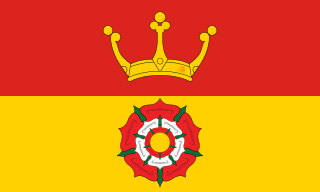
Hampshire is a county in South East England on the coast of the English Channel. The county town is Winchester, but the county is named after Southampton. Its two largest cities are Southampton and Portsmouth which are administered separately as unitary authorities; the rest of the county is governed by a combination of the Hampshire County Council and non-metropolitan district councils.

Winchester is a cathedral city in Hampshire, England. The city lies at the heart of the wider City of Winchester, a local government district, at the western end of the South Downs National Park, on the River Itchen. It is 60 miles (97 km) south-west of London and 14 miles (23 km) from Southampton, its nearest city. At the 2011 census, Winchester had a population of 45,184. The wider City of Winchester district, which includes towns such as Alresford and Bishop's Waltham, has a population of 116,595. Winchester is the county town of Hampshire and contains the head offices of Hampshire County Council.

The Cathedral Church of the Holy Trinity,Saint Peter, Saint Paul and Saint Swithun, commonly known as Winchester Cathedral, is the cathedral of the city of Winchester, England, and is among the largest of its kind in Northern Europe. The cathedral is the seat of the Bishop of Winchester and is the mother church for the ancient Diocese of Winchester. It is run by a dean and chapter, under the Dean of Winchester.

The Piece Hall is a Grade I listed building in Halifax, West Yorkshire, England. It was built as a cloth hall for handloom weavers to sell the woollen cloth "pieces" they had produced.

The River Itchen in Hampshire, England, rises to the south of New Alresford and flows 26 miles (42 km) to meet Southampton Water below the Itchen Bridge. The Itchen Navigation was constructed in the late 17th and early 18th centuries to enable barges to reach Winchester from Southampton Docks, but ceased to operate in the mid-19th century and is largely abandoned today.

New Alresford or simply Alresford is a market town and civil parish in the City of Winchester district of Hampshire, England. It is 7.5 miles (12 km) northeast of Winchester and 12 miles (20 km) southwest of the town of Alton.
Westgate or West Gate may refer to:

Winchester Castle is a medieval building in Winchester, Hampshire, England. It was founded in 1067. Only the Great Hall still stands; it houses a museum of the history of Winchester.
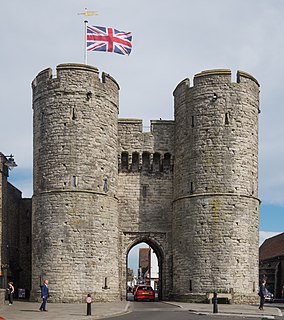
The Westgate is a medieval gatehouse in Canterbury, Kent, England. This 60-foot (18 m) high western gate of the city wall is the largest surviving city gate in England. Built of Kentish ragstone around 1379, it is the last survivor of Canterbury's seven medieval gates, still well-preserved and one of the city's most distinctive landmarks. The road still passes between its drum towers. This scheduled monument and Grade I listed building houses the West Gate Towers Museum as well as a series of historically themed escape rooms.

Sparsholt (/ˈspɑːʃəʊlt/) is a village and civil parish in Hampshire, England, 2+1⁄2 miles (4 km) west of Winchester. In 1908 its area was 3,672 acres (1,486 ha). The 2011 Census recorded its population as 982.
Westbury Manor Museum is the main town centre museum located at 84 West Street, Fareham, Hampshire, England. It features a variety of exhibits on local history, such as the use of Fareham red bricks in the construction of the Royal Albert Hall. It also has a small café and gift shop.
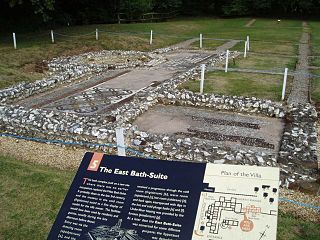
Rockbourne Roman Villa is a Roman courtyard villa excavated and put on public display in the village of Rockbourne in the English county of Hampshire. The villa was discovered in 1942 by a local farmer and excavated by A. T. Morley Hewitt over the next thirty years.

Hyde Abbey was a medieval Benedictine monastery just outside the walls of Winchester, Hampshire, England. It was dissolved and demolished in 1538 following various acts passed under King Henry VIII to dissolve monasteries and abbeys. The Abbey was once known to have housed the remains of King Alfred the Great, his son, King Edward the Elder, and his wife, Ealswitha. Following its dissolution these remains were lost, however excavations of the Abbey and the surrounding area continue.
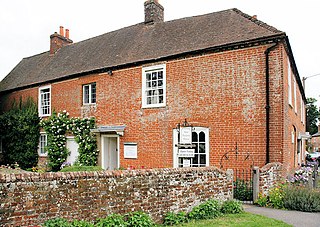
Jane Austen's House Museum is a small independent museum in the village of Chawton near Alton in Hampshire. It is a writer's house museum occupying the 17th-century house in which novelist Jane Austen spent the last eight years of her life. The museum has been a Grade I listed building since 1963.

St. Michael the Archangel Church is the oldest building still in use in the city of Southampton, England, having been founded in 1070, and is the only church still active of the five originally in the medieval walled town. The church is a Grade I Listed building.
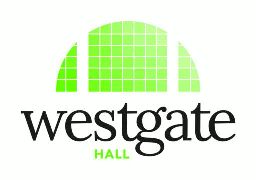
Westgate Hall is a hundred-year-old drill hall and community space in a Conservation area of Canterbury, Kent, notable for hosting community events. The Hall was threatened with closure or demolition in 2009, but a group of local people fought to save it and created the venue it is today. The building is now leased by Curzon Cinemas. Westgate Hall now hosts a range of events from parties to conferences, markets and fairs including the Westgate Hall Market.

Kingsgate is one of two surviving medieval gates to the city of Winchester, England. The name was first recorded in 1148. The gate is on, or near, the site of one of the Roman gates to the city, and was the entrance to the royal palace before the Cathedral Close was enclosed in the 10th century. The present gate is probably 14th century, with 18th-century pedestrian walkways.

The Peninsula Barracks are a group of military buildings in Winchester, Hampshire.

The Westgate area of Gloucester is centred on Westgate Street, one of the four main streets of Gloucester and one of the oldest parts of the city. The population of the Westgate ward in Gloucester was 6,687 at the time of the 2011 Census.

Winchester city walls are a series of defensive walls in central Winchester, originally built during the Roman settlement of southern Britain, in what was then the settlement of Venta Belgarum. The area surrounding Winchester had been populated throughout the Iron Age, with Britonnic settlements existing at Oram's Arbour, St Catherine's Hill, and Worthy Down; Venta Belgarum took its name from the Belgae tribes of the area. Earthwork defences were constructed around the end of the second century, being rebuilt in stone during the latter part of the third century..



















